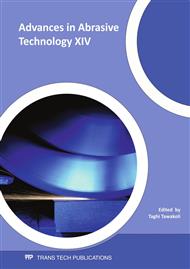p.653
p.659
p.666
p.672
p.678
p.684
p.693
p.699
p.707
Development of CMG Wheels for Stress Relief in Si Wafer Thinning Process
Abstract:
In recent semiconductor industry, production of ever flatter, thinner and larger Si wafer are required to fulfill the demands in high integration and cost reduction. A severe problem encountered in wafer thinning process is the warp and distortion of wafer induced by the residual stress and subsurface damage. Chemo-mechanical grinding (CMG) process is emerging process which combines the advantages of fixed abrasive machining and chemical mechanical polishing (CMP), offers a potential alternative for stress relief. This paper studies the influence of the wheel manufacturing process on the wheel physical properties. Three-factor two-level full factorial designs of experiment are employed to reveal the main effects and interacted effects of mixing method and filtration of raw materials on the bending strength and elastic modulus of CMG wheel. The difference in wheel properties is discussed by association with CMG performance including wheel wear, grinding force and surface roughness.
Info:
Periodical:
Pages:
678-683
Citation:
Online since:
August 2011
Authors:
Price:
Сopyright:
© 2011 Trans Tech Publications Ltd. All Rights Reserved
Share:
Citation:


